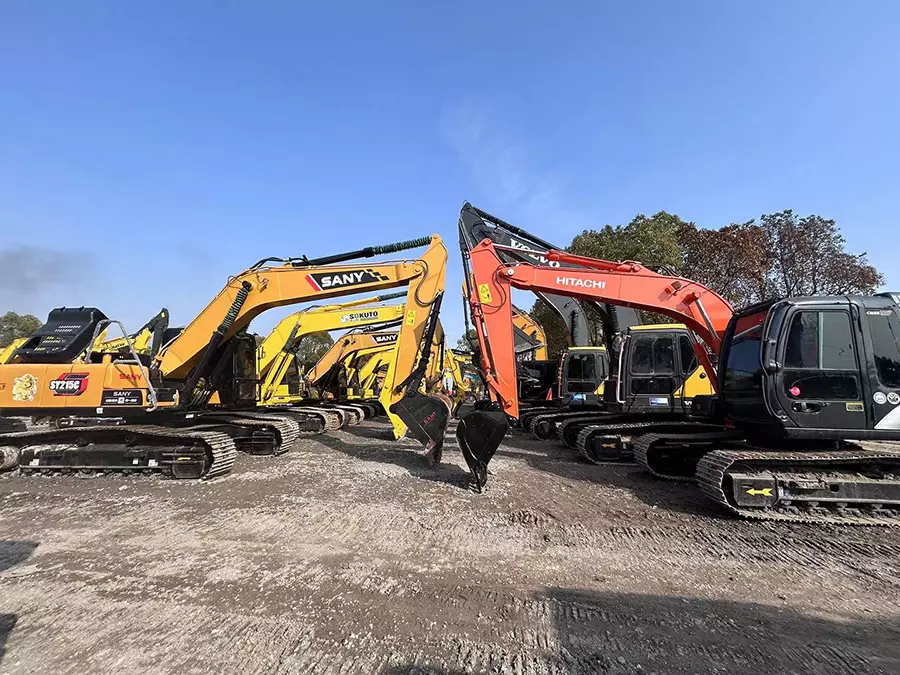How to choose second hand excavator?
Release time: 2025-03-11

1:Check The Nameplate Of Second Hand Exvators To See The Year Of Manufacture Of The Date, The Newer The Date The Better
2: Check The Appearance Of The Used Excavator
Carefully Observe Whether There Are Traces Of Spray Paint On The Door Frame And Window Seals. Any Traces Of New Paint May Hide Flaws You Don’t Want Others To Know About; Check The Frame Welding Points Under The Hood On The Back Of The Used Excavator And Look Carefully To See If The Used Excavator Has Been In An Accident. When Choosing A Second-Hand Excavator. The Original Welding Points Are Smooth And Small, While The Added Welding Points Are Rough And Irregular. If The Latter Welding Point Appears, It Means That The Second-Hand Excavator Has Had A Serious Accident. Also Check Whether The Cab Is Deformed From The Side. If It Is Deformed, It Means Something Has Happened To The Excavator.
3:The Wear Level Of The Track Can Reflect The Frequency Of Use Of A Second-Hand Excavator. If The Tracks Are Flat, Observe The Level Of Track Wear. The Edges Have No Edges And Corners, Indicating That The Owner Of The Original Second-Hand Excavator Drives The Machine More Frequently And Does Not Spare Any Effort. This Not Only Shows That The Track Itself Is In Poor Condition, But Also Reveals That There Are Many Hidden Problems In The Overall Condition Of The Entire Second-Hand Excavator. If The Tracks Are Not Original, It Means That The Vehicle Has Done A Lot Of Work And The Tracks Have Been Replaced. The Chain Can Also Show The Working Condition Of The Second-Hand Excavator.
4:
①:First, Observe Whether The Engine And Hydraulic Pump Have Any Traces Of Disassembly And Repair. If So, Pay Attention.
Observe The Color Of The Exhaust Gas. If The Exhaust Gas Is Translucent And Light Gray, Observe The Appearance And Operation Of The Engine. Check Carefully For Signs Of Oil Or Water Leakage Outside The Engine. Fire The Engine. It Means That The Engine Is In Good Working Condition; If It Is Blue, It Means That The Engine Is Very Tired; If It Is Red, It Means That The Cylinder Gasket Is About To Be Scrapped. Check If There Are Any Abnormal Noises In The Engine And Hydraulic System. Open The Accelerator To The Minimum, Jack Up The Car, And See If There Is Any Strength When The Car Is On The Accelerator. If The Car Stalls, It Means The Car Has No Strength.
②:Rubber Tracks And Undercarriage
As A Result, You Only See Wear On The Rubber Tracks, But Not A Lot Of Wear On The Sprockets And Supporting Wheels. You Can Estimate The Use Of Rubber Tracks By Checking For Cracks And Edge Wear, Paying Attention To The Height Of The Ribs, Just Like You Pay Attention To The Tire Tread When Looking At Tire Wear.
③:Slewing Ring Gear And Slewing Bearing
Check The Slewing Ring Gear And Slewing Bearing Of The Second-Hand Excavator. Under Normal Circumstances, The Upper Part Should Be Able To Start Turning Smoothly And Stop Accurately, With Only A Small Amount Or No Deviation. For A Small Excavator, Its Slewing Ring Gear And Slewing Bearing Should Have As Long A Life As The Machine, So Any Problems In This Part Must Be Paid Attention To.
While You’re Inspecting The Tracks And Undercarriage, Don’t Forget To Drive The Vehicle Again To Check The Oil Level And Cleanliness. This Part Is Easily Overlooked And Usually Very Little Oil Is Left. If The Oil Level Is Already Low And Water Or Something Gets In, It Will Cause Even Greater Trouble.
④:Engine Hood
Because Of Different Soil Conditions And Usage Methods, The Working Life Of Rubber Tracks Also Varies Greatly. Generally Speaking, Its Average Life Is About 2000 Hours. Then, If You Work In An Environment With Rocks Or Easy To Wear, The Service Life Will Be Halved; Conversely, In A Better Environment, The Operating Life Will Be Doubled Accordingly.
The Rubber Tracks On Small Excavators Are Different From The Steel Tracks On Larger Machines And Are Suitable For Use On Grass And Driveways. Most Of The Time You Don’t Inspect Rubber Tracks For Wear As Closely As You Do Steel Tracks.
Key Inspections Also Include Checking The Corrosion Level Of The Battery, Checking The Radiator Fluid And Engine Oil, And Checking For Obvious Leaks Around The Engine.



